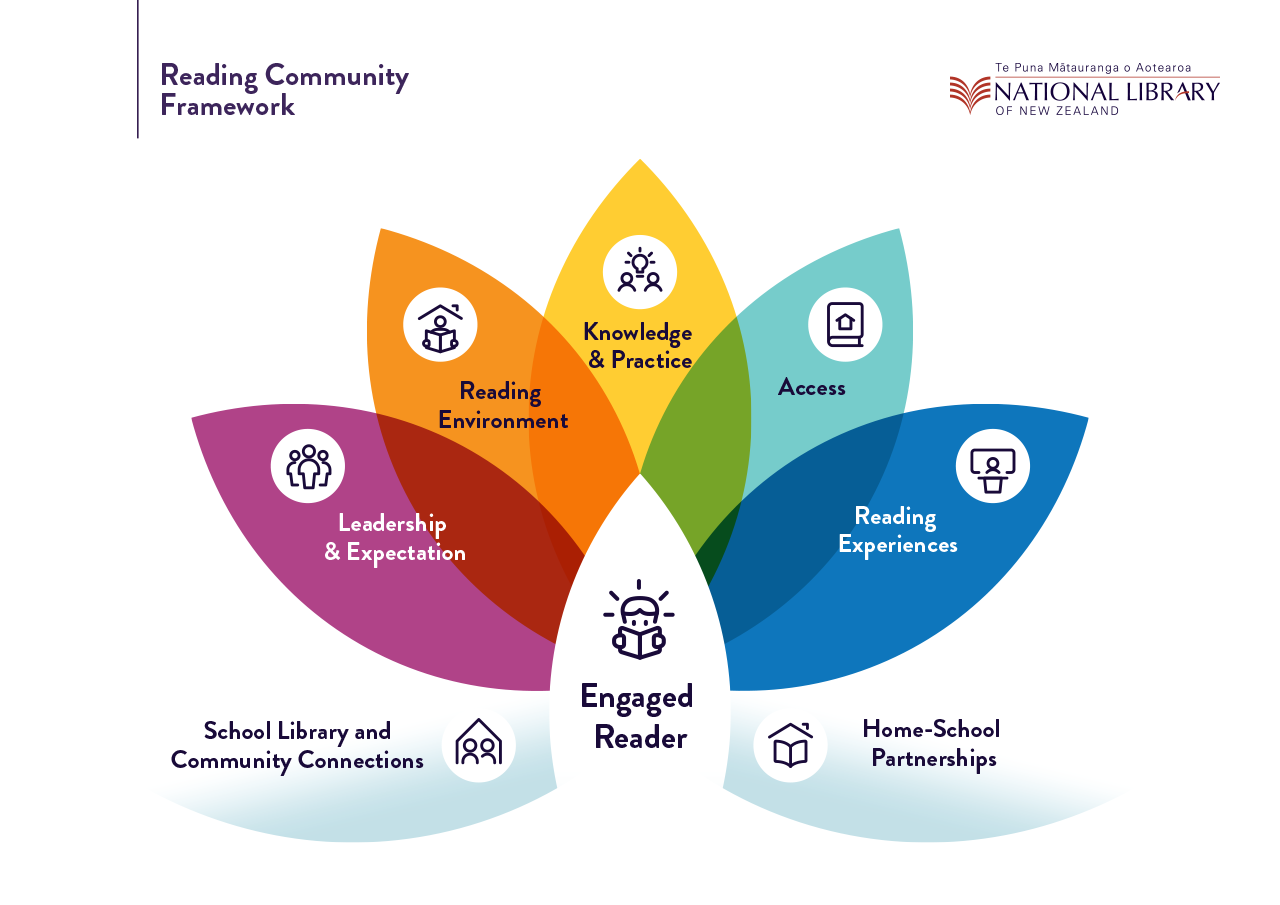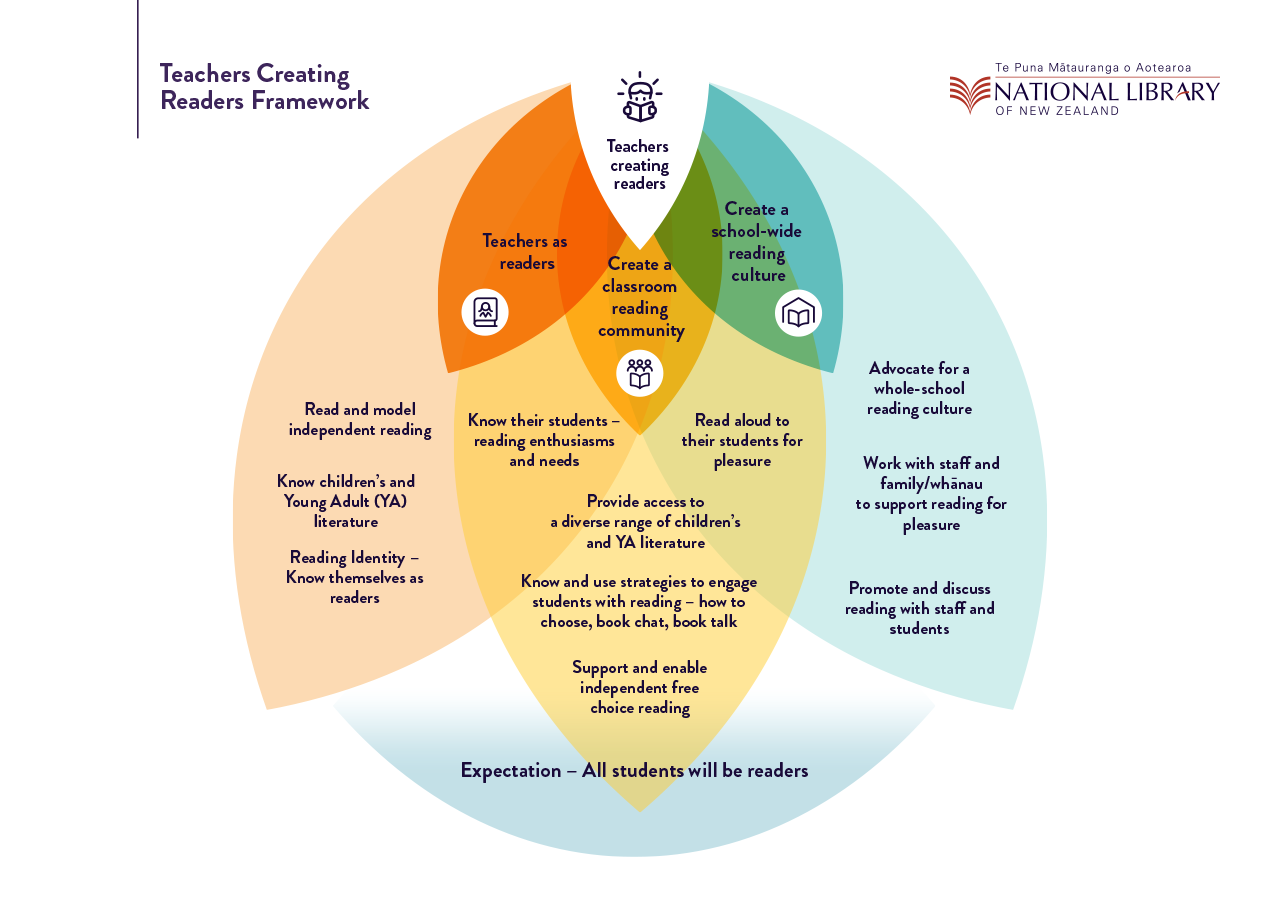
Teachers creating readers — examples of practice

Staff from Kāhui Ako o Tiriwā browsing books at a National Library facilitated professional development event held at Te Manawa library in West Auckland. Image credit: All rights reserved. Used with permission.
Explore the suggested practices you can use in your classroom, library or in the wider school community to put the Teachers Creating Readers Framework into practice. Read our brochure. Use our Examples of Practice tool.
Read our brochure, use the Examples of Practice tool
Download and print the brochure and tool below.
Teachers creating readers: Knowledge and practice brochure (pdf, 4.3MB)
Teachers Creating Readers — Examples of Practice tool (pdf, 452KB).
Or explore the online versions of the brochure (with examples of practice included) on this page.
Teachers creating readers: Knowledge and practice
National Library Services to Schools has developed examples of practice to support teachers to engage students as readers.
The examples align with the knowledge and practice petal — the reading for pleasure pedagogy — of the Reading Community Framework.
The examples can be used in schools and the classroom for years 1 to 13.
2 frameworks — Reading Community and Teachers Creating Readers
National Library's Reading Community Framework is intended for school leaders, teachers and library staff.
It recognises that reading can’t be left to individuals. It requires staff to collaborate and adopt a whole-school approach. This means embedding reading in classrooms, at home and in other aspects of school life, supported by the school library and the leadership team.
The framework draws on research and our years of experience working with school staff to support the development of school reading cultures and school libraries.
It highlights 7 key, interconnecting factors that school communities need to create engaged readers:
leadership and expectation
reading environment
knowledge and practice
access
reading experiences
home-school partnerships
school library and community connections.
Find out more about the Reading Community Framework.

Teachers Creating Readers Framework
The Teachers Creating Readers Framework stems from the knowledge and practice ‘petal’ of the Reading Community Framework. It draws on research and National Library Services to Schools’ extensive experience working with schools to engage students with reading.
The Teachers Creating Readers Framework highlights 3 interconnected ways that teachers can create readers:
Be a reader themselves — ‘teachers as readers’.
Create a classroom reading community.
Create a school-wide reading culture.
Underpinning a school reading culture and best practice is the expectation that all students will be readers.
Teacher Creating Readers Framework

The examples of practice in the booklet and tool
The booklet and tool provide information and examples of practice for each of the 3 focus areas of the framework. The examples of practice are a starting point (in no way exhaustive) for teachers, library staff and schools on their journey in supporting students to become readers.
To spread the message about reading for pleasure, consider things you can do:
in your classroom
when you take your class to the library
in collaboration with library staff
in professional meetings (staff, syndicate — formally and informally)
as part of an appraisal / reflective practice
at school events
online (blog, website, social media).
Teachers as readers
Read and model independent reading
Know children's and YA literature
Have a reading identity — know themselves as readers

Read and model independent reading
Goals: Teachers understand why reading role models matter. They are readers and are seen to read independently, with pleasure, from choice.
When you read, you show children how and why it is important. Commit to being a reading role model in some way each day/week/term.
In primary and secondary schools, it's important for all school staff to share and recommend reading material and books with students — across all learning areas. Students need to see a range of people as readers.
PISA found that there was correlation between enthusiastic teachers and student achievement in reading so consider your role as the teachers as a reader. Share what you are reading with students, what you’re learning as a result. Share new words you're learning, new information. It’s even better if teachers across learning areas share their enthusiasm for reading.
— Dr Irene Anderson, Literacy for secondary learning area teachers (video at 26:57)
Examples of practice
Display the book you’re currently reading (or just finished) on your desk.
Include ‘What I’m reading/have read’ in your email signature.
Display your reading history on your classroom wall/door.
Read at breaks and during independent reading time (SSR/DEAR, library visits etc).
Share with students how you choose/select books, which authors inspire you, how you build cognitive stamina to read deeply, your reading identity.
Talk to students about reading for pleasure beyond your subject area. Recommend and ask for recommendations.
Reflection
Which of these are you already doing?
Which of these do you like and will try?
What other ways have you modelled independent reading?
Know children's and YA literature
Goals: Teachers know and can recommend children's and YA literature. They have strategies to find out about and share new books.
Reading for pleasure and reading widely makes you a great reading role model. Regardless of the age of your students or the subject you teach, the message you send when students know you are a reader matters.
If my reading life was only for myself, I would never read a sports book … setting my own reading desires aside at times and reading wildly in order for my students to have the opportunity to do the same … I need to know all sorts of books …
— Pernille Ripp, The promises we make to our readers
Examples of practice
Discover new books through the National Library:
Set yourself a reading challenge. For example, read book award winners, book-to-screen adaptations.
Track your reading, for example, using library apps or on Goodreads.
Ask for recommendations from students, school library staff, colleagues or from professional learning networks (listservs, social media teacher groups).
Visit public libraries and bookshops (online and in person) to see recommendations and events.
Join book clubs — staff, online, friends, family/whānau, kahui ako, social media.
Follow social media, blogs, podcasts and review sites.
Reflection
Which of these are you already doing?
Which of these do you like and will try?
What other ways have you got to know children’s and YA literature?
Have a reading identity – know themselves as readers
Goals: Teachers reflect on their own experiences of reading and as a reader. They share their reading lives to support students to develop their reading identities.
Knowing yourself as a reader requires you to reflect on your reader identity and share this with others.
Reading teachers are enthusiastic reading role models. They realise readers are individuals and that a reading identity is fluid. Sharing your reading identity with students will have a positive impact on their desire to read. Ultimately, teachers who are readers, create readers.
The passion I am asking for from teachers is a passion beyond the pay cheque. It’s a passion for children’s books, as well as for their own reading, for if teachers don't love to read, why on earth should children?
— Mem Fox, Like mud, not fireworks
Examples of practice
Increase your knowledge of your reading identity by reflecting on the following questions:
What do you enjoy about reading? What motivates you to read?
What are your reading interests and frustrations?
What book or person influenced your reading life?
How do you choose a book, what makes you pick one up?
What makes you give up on a book?
How have your reading habits changed?
What prevents you from reading? What could you do to increase the likelihood of reading more?
Reflection
What have you learnt about yourself as a reader?
What other ways have you got to know yourself as a reader?
Create a classroom reading community
Know your students' reading enthusiasms and needs
Read aloud
Provide access to a diverse range of children’s and YA literature
Know and use strategies to engage students with reading
Support and enable independent free-choice reading

Know your students' reading enthusiasms and needs
Goal: Discover students' reading preferences and practices in and out of school. This will help you recommend titles and show students how to choose books to read for pleasure.
Knowing your students’ reading interests, attitudes and behaviours in and out of school enables you to make recommendations. It also builds relationships and trust and affirms students’ reading identity.
Examples of practice
Observe students in the library and class, and track their reading preferences.
Create or play games or activities that give you insight into their reading identity. Examples include reading rivers, book blankets, desert island texts, ‘would you rather’.
Survey students' reading history, interests, behaviours and attitudes.
Plan and allocate time to have formal and informal book chats and book selection conversations — whole class, groups, pairs.
Provide opportunities for students to express their voice, for example:
votes for best book/film or screen adaptation, best quote, best first line, best main character
allow them to request books for purchase or loan requests, books for read-aloud, books to include in the classroom library.
Know your community profile.
Talk to other people about your students' reading lives (colleagues, family/whānau, coaches etc).
Liaise with school library staff to access borrowing data and gain insights into students’ interests.
Reflection
Which of these are you already doing?
Which of these do you like and will try?
What other ways have you got to know your students reading enthusiasms and needs?
Read aloud
Goals: From primary through to senior secondary, read aloud for pleasure frequently and regularly from a diverse range of children's and YA literature. Read aloud from across the curriculum.
Reading aloud to children and teenagers is enjoyable, stimulates interests and imagination, and improves language.
Reading aloud provides students with opportunities to hear stories they may not usually choose or are beyond their independent reading level. Match the length of the read-aloud to the attention span and listening skills of your students (start short, build stamina).
It is not an optional ‘extra’ activity, but every child's right to hear fiction, non-fiction and poetry read aloud with passion and pleasure.
— Teresa Cremin, Keep reading to children into their teenage years, urge experts, 2019
Examples of practice
Provide dedicated regular and frequent time for reading aloud for students of all ages:
Read aloud across the curriculum in primary and secondary, for example, fiction tied to science, maths etc.
Swap classrooms/age levels with colleagues.
Speed-date read-alouds.
Read aloud from a range of formats and genres, fiction and non-fiction.
Ask library staff for suggestions.
Request read-alouds through a National Library loan.
Promote World Read Aloud Day, Global Read Aloud and #NZreadaloud.
Promote school initiatives such as grandparents read aloud, the big bedtime read, animal read-aloud, lunchtime read-alouds.
Encourage principals, school leaders, prefects/student body leaders to read aloud sections from their favourite books in assemblies, over the PA system, in the library during breaks.
Reflection
Which of these are you already doing?
Which of these do you like and will try?
What other ways have you included reading aloud into your practice?
Provide access to a diverse range of children’s and YA literature
Goal: Ensure students have regular and frequent access to an up-to-date diverse and appealing range of print and/or digital books to read for pleasure at school and home.
Students with access to great reading material are more likely to pick up a book. The more they read, the easier and more enjoyable it becomes, which creates a ‘virtuous circle’ of constant improvement. Access to books at home and at school is important.
A graphic novel one day, a cool app the next, a novel on a third day, or a poem, a play, an investigative article, a description of a new discovery. The idea is to keep opening doors, so occasional readers recognize that there is something of interest — something appealing, stimulating, or unexpected — waiting for them when they do take the time to read.
— Marc Aronson, Are teenagers reading less? | Consider the source
Examples of practice
Prioritise and ensure regular visits to the school library, with time for selection and discussions.
Request National Library loans and promote these in the school.
Schedule visits to your public library and encourage students to visit out of school time.
Keep an up-to-date, appealing, diverse classroom library collection:
Provide a range of genres and formats (print, ebooks, audio, magazines)
Ensure it allows for choice and reflects your students and community.
Advocate for reader-friendly school library policies and environments.
Provide access to books all around the school (office, sickbay).
Reflection
Which of these are you already doing?
Which of these do you like and will try?
What other ways have you provided access to a diverse range of children’s and YA literature?
Know and use strategies to engage students with reading
Goals: Teachers know how to share and chat about books with students. They know how to develop strategies and approaches to encourage students to share about books with each other. Provide students with frequent and regular opportunities to talk about books, stories and reading.
Reading is both an independent and social activity. Creating opportunities to build a reading community will support students to read for pleasure. This includes strategies for choosing books, how to participate in different activities within a reading community and how to celebrate reading.
Teachers had kids sitting on beanbags in the library reading books, chatting, sharing books and pointing out things in each other's books. This social aspect of reading was important … They also talked about texts in different ways from how you might talk about a text in a guided reading lesson. It was about interest and pleasure and connecting … it wasn't about seeing whether that child had read the book, whether they understood the book … it wasn't performative.
— Sue McDowall (NZCER), How teachers who read create readers
Examples of practice
Model book talks, book selection and reading behaviour strategies.
Schedule time for text recommendations. This could include formal and informal book chats and reading buddies.
Create opportunities for peer recommendations such as student book reviews or student-created displays.
Organise book talks in assemblies and at the start or end of lessons.
Schedule personalised time with each student to discuss strategies and make book suggestions.
Reflection
Which of these are you already doing?
Which of these do you like and will try?
What other ways have you engaged students with reading?
Support and enable independent free-choice reading
Goals: Prioritise regular time for independent, free-choice reading (SSR. DEAR etc). Allow time for students to browse and choose from a range of reading material, settle into the experience and build stamina over time. Role model reading. Share and chat about their reading in all classes.
Scheduled independent free-choice reading at school is important. It helps students develop reading stamina, increase vocabulary and knowledge, and build reading habits. For some students, school is the only place where they can read for pleasure independently.
Where we can provide that opportunity for deep and sustained reading in a school context, not only are we providing students opportunity to be exposed to vocabulary, to build their reading comprehension, we're also communicating to young people that it's something that's valuable enough to give valuable time up from the curriculum to devote to the practice.
— Margaret Merga, The Research Files Episode 53: Building a school reading culture
Examples of practice
Schedule regular independent reading time.
Set up expectations that students always have a book with them.
Provide a comfortable environment.
Create a collection that allows choice, multiple formats and is easily accessed. Display it to encourage engagement, for example, face out or ‘genrefied’.
Allow students to choose themselves, and don’t judge their choices.
Lead by example — ‘teacher as a reader’. For example, read while students are reading, engage in book chat, schedule read-alouds.
Create themed weeks to support the breadth of texts (authors, topics, genres).
Draw on the expertise of your school library staff to upskill you and engage your students.
Reflection
Which of these are you already doing?
Which of these do you like and will try?
What other ways have you supported and enabled free-choice reading?
Create a school-wide reading culture
Advocate for a whole-school reading culture
Work with staff and family/whānau to support reading for pleasure
Promote and discuss reading with staff and students

Advocate for a whole-school reading culture
Goals: Know the research about why reading for pleasure is important and how it makes a difference. Advocate across the school community for reading for pleasure. Share the message with school leadership, staff in their school and across schools, and family/whānau.
A whole-school reading culture provides an environment where reading is valued and supported. There is an expectation by all that students will be readers.
If teachers model positive attitudes toward reading, promote the ongoing importance of reading, and give students a chance to build the cognitive stamina needed to read deeply, we can increase the chance of students choosing to read beyond school.
— Margaret Merga, How to encourage teens to read
Examples of practice
Provide bite-sized research facts in every staff meeting to advocate and raise awareness. See our research page.
Encourage and support teachers to read relevant educational research.
Use the National Library School Reading Culture Review tool.
Investigate whole-school priorities. Which of the elements within the Teachers Create Readers Framework could you focus on collectively (refer to each element for specific examples to support)?
Complete a reading culture walk-through of your school. What do you see or hear to indicate that reading is important?
Set up a reading team involving members from across the school community (staff and students).
Provide opportunities for reading projects such as creating a cross-curricular book or community book trail.
Reflection
Which of these are you already doing?
Which of these do you like and will try?
What other ways have you advocated for a whole-school reading culture?
Work with staff and family/whānau to support reading for pleasure
Goals: Collaborate with other teachers, library staff and family/whānau to share ideas, develop measurable initiatives, ensure access to reading resources and strengthen support for students reading for pleasure at school and at home.
A school-wide reading community requires all members to work together to support and encourage reading for pleasure. Working together ensures that students receive inclusive and consistent messaging about reading from home and school.
… children's enjoyment of reading is related to a longer life, better mental well-being and healthier eating … But reading for pleasure is also good for communities because readers tend to be good at making decisions, have more empathy and are likely to value other people and the environment more.
— Kiwi kids who read for pleasure will do well in other ways — it’s everyone’s responsibility to encourage them
Examples of practice
Focus on reading for pleasure during parent/teacher meetings as a discussion topic.
Schedule sessions with whānau to promote or encourage reading for pleasure. For example, promote public library membership, suitable apps and book review sites, how to download and use eBooks, audiobooks.
Provide access to books during holidays. For example, summer reading loans, backpacks of books chosen from information provided by families.
Explore family/whānau engagement and understanding of reading for pleasure through discussions and surveys.
Include family/whānau in school reading celebrations.
Reflection
Which of these are you already doing?
Which of these do you like and will try?
What other ways have you worked with staff and family/whānau to support reading for pleasure?
Promote and discuss reading with staff and students
Goal: Promote reading for pleasure in a variety of ways to ensure it is visible and modelled, celebrated, supported and encouraged. For example, use displays, events, author visits, book clubs for students and staff and chats from the classroom to the staffroom.
Reading is a social activity — influenced by and influencing others. Promoting and discussing reading is one way to build a sense of community.
Reading and storytelling has spread throughout many facets of the school, through reading relationships, texts shared, online engagement and community activities. These outcomes suggest a culture of reading is seeded by people who have interest, commitment, knowledge, resources, authority, and a willingness to collaborate.
— Research report, school project, Pūtoi Rito Communities of Readers Phase 1: 2019–2021 summary and insights report
Examples of practice
Schedule regular reading celebrations/activities throughout the year for the school community such as book days/weeks, inter-class challenges.
Promote reading challenges to get staff and students reading more, for example, Read Around the World, Take 10, Get Caught Reading.
Arrange for author/illustrator visits through ReadNZ or Storylines.
Plan a summer reading initiative.
Run book clubs — staff and student.
Create or take part in competitions and quizzes, for example, Kids’ Lit Quiz, Readers' Cup, Battle of the Books.
Reflection
Which of these are you already doing?
Which of these do you like and will try?
What other ways have you promoted and discussed reading with staff and students?
Find out more
Reading engagement — creating engaged readers takes commitment to developing a reading culture that actively encourages, supports and models reading for pleasure. Find advice and support for creating a school-wide reading culture with the school library at its heart.
Pūtoi Rito Communities of Readers — a collective impact project that works with different communities across New Zealand. It aims to grow reading for pleasure and wellbeing amongst children and young people.
Create readers blogs — inspiring articles about reading, why it’s important, and ideas and advice about how to create a reading culture in schools.
Guides for exploring literature — the Book and Beyond guides are tools to help teachers and library staff discuss children’s and YA literature with colleagues or with students. Prompts in the tools invite readers to explore, and reflect on and discuss elements of a book and how they add to understanding and enjoyment.
Lending service — schools and home educators can borrow from our extensive collections of fiction and non-fiction books. Expand your classroom or school library and keep it fresh and relevant. Use our expertise to get books that will inform and inspire your students’ inquiry and develop their love of reading.
Capability service — we strengthen the knowledge and skills of school library staff, teachers and school communities by providing professional learning (for example Teachers Creating Readers modules), support and advice.
Our work — read more about what National Library Services to Schools does.